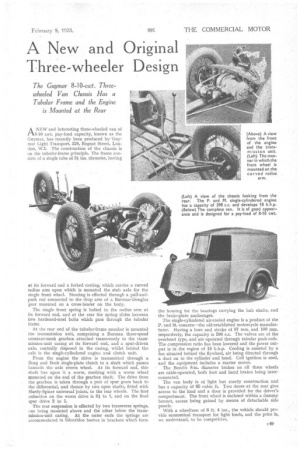A New and Original Three-wheeler Design
Page 111

If you've noticed an error in this article please click here to report it so we can fix it.
The Gugrnar 8-1 0-cwt. Threewheeled Van Chassis Has a Tubular Frame and the Engine is Mounted at the Rear ANEW and interesting three-wheeled van of 8-10 cwt pay-load capacity, known as the Guymar, has recently been produced by'Guymar Light Transport, 324, Regent Street, London, W.1. The construction of the chassis is on the tubular-frame principle. The frame consists of a single tube of 3s ins, diameter, having at its forward end a forked casting, which carries a curved radius arm upon which is mounted the stub axle for the single front wheel. Steering is effected through a pull-andpush rod connected to the drop arm of a Burman-Douglas gear mounted on a cross-bearer on the body.
The single front spring is bolted to the radius arm at its forward end, and at the rear the spring slides between two hardened-steel bolts which pass through the tubular frame.
• At the rear end of the tubular-frame member is mounted the transmission unit, comprising a Burman three-speed constant-mesh gearbox attached transversely to the transmission-unit casing at its forward end, and a spur-driven axle, centrally disposed in the casing, whilst behind the axle is the single-cylindered engine and clutch unit.
From the engine the drive is transmitted through a Borg and Beck single-plate clutch to a shaft which passes beneath the axle crown wheel. At its forward end, this shaft has upon it a worm, meshing with a worm wheel mounted on the end of the gearbox shaft. The drive from the gearbox is taken through a pair of spur gears back to the differential, and thence by two open shafts, fitted with Hardy-Spicer universal joints, to the rear wheels. The first reduction on the worm drive is 3t to 1, and on the final spur drive 2 to 1.
The rear suspension is effected by two transverse springs, one being mounted above and the other below the transmission-unit casing. At the outer ends the springs are accommodated in Silentbloc bushes in brackets which form the housing for the bearings carrying the hub shafts, and the brake-plate anchorages.
The single-cylindered air-cooled engine is a product of the P. and M. concern—the old-established motorcycle manufacturer. Having a bore and stroke of 87 mm and 100 mm. respectively, the capacity is 598 c.c. The valves are of the overhead type, and are operated through tubular push-rods. The compression ratio has been lowered and the power output is in the region of 18 b.h.p. Cooling is assisted by a fan situated behind the flywheel, air being directed through a duct on to the cylinder and head. Coil ignition is used, and the equipment includes a starter motor.
The Bendix 8-in. diameter brakes on all three wheels are cable-operated, both foot and hand brakes being interconnected.
The van body is of light but sturdy construction and has a capacity of 65 cubic ft. Two doors at the rear give access to the load arid a door is provided for the driver's compartment. The front wheel is enclosed within a dummy bonnet, access being gained by means of detachable side panels. With a wheelbase of 6 ft. 4 ins., the vehicle should provide economical transport for light loads, and the price is, we understand, to be competitive.














































































































































































